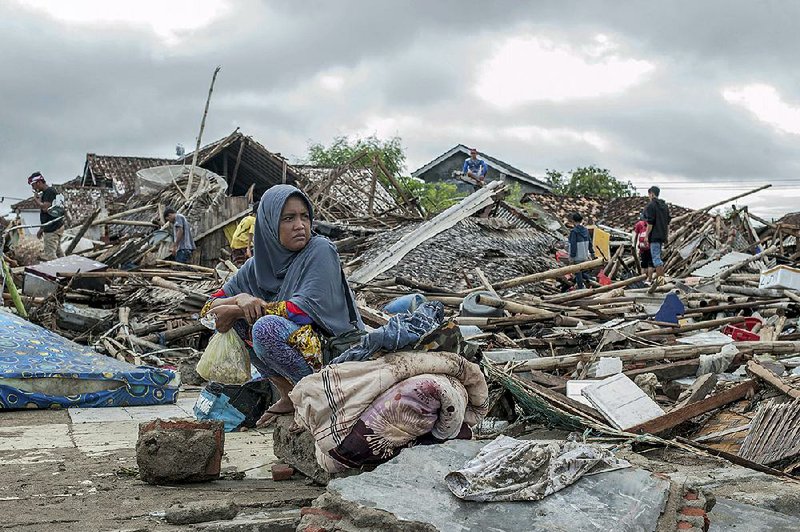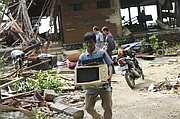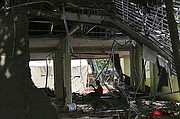TANJUNG LESUNG, Indonesia -- Efforts to collect hundreds of bodies and save the injured were stepped up Monday in Indonesia after Saturday's tsunami, as scientists gathered evidence to determine how a volcanic eruption triggered the weekend tragedy.
Casualty figures from Saturday night's tsunami continued to rise, with at least 373 people confirmed dead and more than 1,400 injured. An estimated 128 people were still missing Monday in the affected areas along the coastlines of western Java and southern Sumatra islands, where hundreds of military personnel and volunteers searched for survivors along debris-strewn beaches.
More than 5,000 people have been displaced by the tsunami.
The waves that swept people into the sea along the Sunda Strait followed an eruption and apparent landslide on Anak Krakatau, or "Child of Krakatoa," one of the world's most infamous volcanic islands.
On Saturday night the ground did not shake to alert people before the giant waves ripped buildings from their foundations and swept away people celebrating on a resort beach.
"I heard people shouting to run away, and I saw the water had gone up to the mainland and the hotel had been flooded by water," said witness Feri Ardian. "About 200 people were dragged away by the waves."
Indonesian President Joko "Jokowi" Widodo toured damaged areas along the Sunda Strait on Monday, some of which had been quickly cleared of debris before his visit.
In Java's Banten province, the hardest-hit area, he talked with survivors at a clinic and at a camp set up to house those who lost their homes.
"I want to see firsthand the handling of the post-tsunami that swept the coast around Sunda Strait," he told reporters, adding that he has ordered the Social Ministry to give compensation to the families of the dead as quickly as possible.
The Indonesian president praised the army and police, along with local government officials, for their work in evacuating the coastal areas.
It was the second time in three months that a deadly tsunami has hit Indonesia without advance warning. An earthquake and tsunami that struck Sulawesi island Sept. 28 killed more than 2,100.
But even in a disaster-prone country, survivors of Saturday's tsunami said the wave of water seemed especially menacing because everything seemed perfect until the moment it hit.
"That night was a nightmare," said Mamad Setiadi, who had helped set up the stage at the Tanjung Lesung Beach Club for the pop band Seventeen, which was caught on video performing as the tsunami hit. "I cannot forget it for the rest of my life."
CHUNK OF LAND GONE
Scientists said satellite images of Anak Krakatau showed that a significant chunk of the island's southwest flank, visible before the tsunami, had vanished after the giant wave struck the coast.
That could indicate, scientists said, that a large amount of soil may have slid into the ocean, displacing enough water to create the tsunami.
Dwikorita Karnawati, the head of Indonesia's Meteorology, Climatology and Geophysics Agency, said the images of the 1,000-foot-high volcano showed a 158-acre deformation on its southwest side. The volcano has been erupting since June and did so again 24 minutes before the tsunami, the agency said.
Eko Yulianto, a tsunami expert at the Indonesian Institute of Sciences, said it was too soon to tell what caused the deformation.
"We need to determine whether a landslide actually occurred there," Eko said.
Costas Synolakis, director of the Tsunami Research Center at the University of Southern California, said a tsunami generated by volcanic activity on Anak Krakatau should not have come as a surprise. The island was formed after the eruption of the original Krakatoa in 1883, one of the largest eruptions in recorded history.
"It was well known that Krakatoa was again in a paroxysm, and tsunamis from submarine landslides triggered by eruptions were not unexpected," he said. "What was unexpected was that local residents were apparently not forewarned to be extra vigilant for unusual water motions as the volcano was erupting."
Jokowi vowed Monday to have all equipment used for detection of tsunamis replaced or repaired.
Eko said the island's buoy-based tsunami detection system might have saved lives, but it was abandoned after some of the buoys were hit by ships. Other buoys are simply missing.
Sutopo Purwo Nugroho, spokesman for the Indonesia Disaster Mitigation Agency, acknowledged on Twitter that the country's network of tsunami detection buoys had been dysfunctional since 2012. He blamed vandalism and budget shortfalls.
Dwikorita said Monday that because the tsunami was caused by Krakatau's volcanic activity, it could not have been picked up by her agency's sensors, which monitor the conventional tectonic earthquakes that are responsible for more than 90 percent of Indonesia's tsunamis.
With Anak Krakatau still erupting, she warned people to avoid activities around coastal areas for at least the next two days.
Synolakis said tide gauges in the Sunda Strait could have given some people on the coast enough warning to flee the coastline.
Even posting lifeguards on the beach to watch for unusual water motion could have given some people time to flee.
"Warnings from lifeguards allow at best for a few extra minutes for evacuations, but of course they are better than no warnings at all," he said. "With hindsight, it is clear that a few extra tide gauges around the islands in Sunda Strait would have saved lives, even without offshore buoys."
The death and injury toll was relatively high because many people were at the beach Saturday evening enjoying a long holiday weekend. Many others lived close to the beach, especially on Java, an island about the size of Mississippi that is home to more than 140 million people.
Information for this article was contributed by Niniek Karmini, Margie Mason and Ali Kotarumalos of The Associated Press; and by Muktita Suhartono and Richard C. Paddock of The New York Times.
A Section on 12/25/2018



